L.A. Lewandowski's Blog: The Culture and Cuisine Club, page 7
June 25, 2014
Orzo with Peas, Pancetta, and Dill
Recipes
I made this pasta salad to accompany a salad Niçoise during the World Cup. It was delicious, but it needed a bit of acid. I suggest a tablespoon or two of freshly squeezed lemon juice to perk it up.
Ingredients:
1 pound orzo (rice-shaped pasta)
6 ounces pancetta (Italian bacon), chopped (about 1/2 cup)
1 cup chopped shallots (about 4)
2 cup shelled fresh peas or frozen petite peas, thawed
6 tablespoons chopped fresh dill, divided
1 1/2 cups low-salt chicken broth
1 – 2 tablespoons sherry wine vinegar
Method:
Cook orzo in large saucepan of boiling salted water until tender but still firm to bite, stirring occasionally. Drain.
Meanwhile, sauté pancetta and chopped shallots in heavy large skillet over medium-high heat until brown, about 4 minutes. Add peas and 4 tablespoons chopped dill; stir to coat. Add chicken broth and boil until reduced by half, about 4 minutes. Add sherry wine vinegar; boil 1 minute. Add orzo to skillet; stir to coat. Season to taste with salt and pepper, and add lemon juice. Transfer to medium bowl; sprinkle with remaining 2 tablespoons chopped dill. Serve warm or at room temperature.
Source: Bon Appétit and Epicurious
June 18, 2014
Authors Eat… Meets RJ Crayton
Have you missed me? I have been swamped with writing projects and travel. We just got back from a lovely wedding in New England, and helped celebrate the vows of a young couple in the Battell Chapel on the old Yale Campus. I was excited to find this post and recipe from author RJ Crayton waiting for me.

Author RJ Crayton
RJ is a writer who knows how to get things done. She has a full-plate of family and community responsibilities that she balances with her career as an author. I have grown to appreciate her insightful observations, and I’ve learned quickly that if RJ asks a question the answer will be important. She is a woman you want to pay attention to. What’s more, she’s fun, she laughs a lot, and that is what life is all about. And now in the author’s own words…
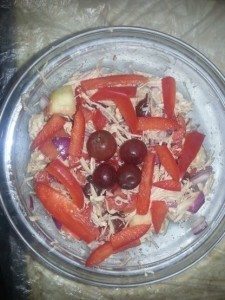
This is what the dish looks like at the end. I added some grapes and red pepper strips as a garnish.
Cool and Tasty Summertime Dish
by RJ Crayton
When Lois invited me to do this, I started racking my brain to think of what recipe I could use. Then it hit me: since my novel is about a woman desperately fleeing a forced kidney transplant, I should offer up a recipe for kidney pie. Yum! Wait … no! Kidney pie sounds disgusting. Are there real kidneys in that? Hold on. Let me check.
Yep there are. They use ox kidneys, according to the BBC If you try to use lamb or pig kidneys, it won’t taste as good. And they recommend you start the cooking process at least 48 hours in advance. Ummm, I don’t have time to cook a meal over a three-day period.
So, in the alternative to kidney pie, let’s actually make something I know how to cook that doesn’t involve trying to find a butcher who has an ox kidney (or what he says is an ox kidney).
It’s starting to get hot here in the Washington, DC, area, and in the summertime, I prefer not to heat up the kitchen cooking all the time. On the really hot days, it seems nuts to air condition the house and then add heat from the oven to it. So, I like to make this great chicken salad dish, which is tasty, fresh and cold. It fits with my cooking style in that it’s not complicated to make. All you have to do is have the ingredients. I’m a minimalist in cooking so I prefer not to make anything that involves too much drama. I also like tasty dishes, so those that can conflict with minimalism at times, but that’s why we have restaurants, right? Someone else can spend hours slaving over a hot pot so I can enjoy a tasty meal; I used to get that for free (thanks, Mom!), but now it only happens when I pay the waiter.
So, this dish involves a bit of slicing and dicing, but it’s pretty easy and requires no cooking. The best part is, if you have a kitchen helper who’s super excited to cut stuff up, the way my daughter is, then you don’t have to dice at all, if you don’t want to. If you do want to, I suggest you have an epic rock paper scissors battle to decide who gets to do it. On a more serious note, I don’t recommend letting small children cut onions; if they don’t wash their hands well and get the juice in their eyes, it’s a bad scene. I made this dish the other day with my 7-year-old daughter, and she suggested her doll Kittyanna help us out.

This is Kittyanna with the final dish. My daughter actually changed Kittyanna’s clothes, because, y’know, you have to look good posing with the food.
Ingredients
1 ½ cups of chicken (you can pull leftovers from a baked chicken or use a can of chicken, drained)
½ red pepper, diced
⅓ red onion, diced
10 grapes (I like to cut them in half, but my hubby says that’s overkill)
½ apple, cut into quarter-inch chunks
Balsamic vinegar (a few splashes, to taste)
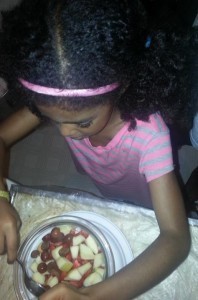
This is my daughter stirring everything, prior to adding vinegar.
Basically, you just toss all the ingredients, except the last, in a bowl, and mix them up. Then, add enough balsamic vinegar to lightly coat your dish. It usually only takes three or four splashes. However, if you like a more vinegary tasting dish, add some more. It tastes great in a pita pocket, or on any bread that can stand up to a moist filling. Sometimes if I’m making this, I’ll also make a bean salad. As I’m simple, I make a bean salad using a can of pinto beans, drained (though you can use any kind of beans you like–perhaps kidney beans), and a quarter jar of Trader Joe’s Corn and Chile tomato-less Salsa. That’s a great side because it’s super quick.
RJ Crayton is a former journalist turned novelist. By day, she writes page-turning fiction and regularly blogs for Indies Unlimited and the Institute for Ethics and Emerging Technologies . By night, she practices the art of ninja mom.
To learn more about RJ or her books, visit her Amazon Author page: http://www.amazon.com/RJ-Crayton/e/B00DFQ5F24
Rj also has a blog, http://rjcrayton.com/
* * *

I think Kittyana thinks the vinegar is cooking sherry. No no, naughty Kittyana.
May 21, 2014
Slow Cooked Lamb Shanks
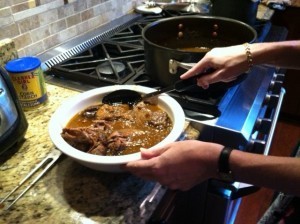
Slow cooked lamb shanks
One of the side benefits of cleaning that pile of papers on your desk is coming across a gem like this recipe. A lovely woman who also happens to be an exceptional cook gave it to me a few years ago. I am sharing it despite the fact that I haven’t made it yet. When I do I will update the recipe with my comments and tips. If you prepare it and have any suggestions please let me know. Enjoy!
Ingredients:
4 lamb shanks
1 tablespoon olive oil
24 ounces beer (or 12 ounces beer & 12 ounces water)
1 bunch fresh cilantro leaves, washed well
1 1/2 teaspoons brown sugar (I use brown sugar Splenda)
1 large onion, chopped
3 medium tomatoes
2 tablespoons ketchup
1 carrot
1/2 stalk celery
1 garlic clove
1 teaspoon salt
1/4 teaspoon pepper
1/4 teaspoon cumin powder
Method:
Brown meat and onion in olive oil. Remove meat to slow cooker or heavy dutch oven.
Place onion, tomatoes, cilantro, carrot, celery, garlic, brown sugar, ketchup, seasonings & beer in food processor. Process until everything is thick puree consistency.
Pour beer mixture over the lamb and cook at low heat for 2-3 hours if stove-top. If you are using the oven, 325 degrees for 2-3 hours. If using a crockpot, cook on low for 4-6 hours, depending on size of the shanks.
May 7, 2014
Vietnamese-American Thanksgiving Red Cabbage Salad
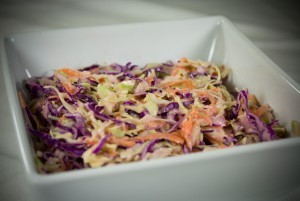
Red cabbage, carrot, and fennel slaw.
This past Saturday the C & C Club got together for a delicious Vietnamese dinner. The hostess sent me this recipe and I was delighted to make it.
2 Thai, Fresno or serrano chiles, chopped
1 large clove garlic, chopped
1/2 teaspoon plus 1 teaspoon sugar
1 pinch salt
2 to 2 1/2 or more tablespoons fish sauce
5 plus tablespoons unseasoned Japanese rice vinegar
3 carrots, cut into julienne or matchsticks
1 fennel bulb, cored and thinly sliced (1 cup / 115 g total)
4 cups packed / 200 g shredded red cabbage
3 plus tablespoons chopped fresh mint and/or basil (Thai or Italian) leaves
3/4 cup toasted cashew halves and pieces
Instructions
Use a mortar and pestle to mash the chile, garlic, ½ teaspoon sugar, and salt into an smooth paste. Scrape it into a bowl and add the remaining teaspoon of sugar, fish sauce and rice vinegar. Stir to dissolve the sugar and salt. Taste and tweak to create a spicy, tart, savory, lightly garlicky dressing.I added more fish sauce and more rice wine vinegar.
In a large bowl, combine the carrot, fennel, cabbage, herb, and cashew. Pour the dressing over the salad and toss well, either with tongs or better yet, with your hand in a gentle massaging motion. The vegetables will soften slightly but remain a little crunchy. Taste and adjust the flavors to your liking, balancing the sour, sweet, salty, and spicy. Transfer to a serving plate, leaving any unabsorbed dressing behind, and serve.
Origin: Viet World Kitchen
April 23, 2014
The Importance of Rituals

Miranda
What is your morning ritual?
My morning starts with a strong cup of Starbuck’s French Roast enjoyed outside on the lanai. This morning I donned my heavy winter robe and sat for a few silent minutes while the world awakened. The birds went about their business of establishing territories or finding food for their young, singing as they worked. I looked around at my plants, thanking them for their gift of beauty to help me start my day.
My morning ritual is not idle time. While the caffeine clears the cobwebs from my mind I think about what I need to accomplish that day. I often find the answer to a question that has been troubling me will become crystal clear. This alone time is, I suppose, a form of meditation. I know that when I don’t follow this ritual I feel less centered and will accomplish less.

Classy Lady
That is the contradiction. The few minutes I allow myself enable me to give generously to my family, my friends, and myself. The ritual fills the glass that I empty while living my life. I hope you will take the time to establish a ritual for yourself, whether it is in the morning or the evening.

Angelique
I have shared a few photos of my orchids with you to enjoy. Have a lovely day.
April 16, 2014
Quick Pumpkin Chocolate Bread
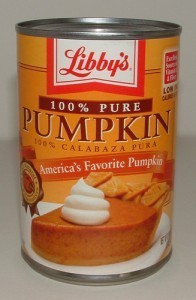
Don't waste me!
I was reorganizing the pantry the other day and I came across a can of pureed pumpkin. In our home pumpkin is usually reserved for holiday dishes, however, I was raised in a frugal household and never waste food. What should I make? I looked over to the Brian Urlacher chair where my husband sat with his feet propped up watching the Master’s. He had completed his honey-do list, so I threw together the following recipe as a treat. The pumpkin bread was moist and flavorful with lots of spice. I froze a loaf to share with my tennis friends after our next match. Enjoy!
Ingredients:
3/4 15 ounce can Libby 100% pumpkin puree 1 cup Ghiardelli semi-sweet chocolate chips 3 eggs 3/4 cup veggie oil 1/2 cup water 1 3/4 cups sugar, more to your taste 3 cups flour 1 1/2 teaspoons baking soda 1 teaspoon salt 1 teaspoon ground cinnamon 1 teaspoon ground nutmeg 1/2 teaspoon ground cloves 1/4 teaspoon ground ginger
Method:
Preheat oven to 350 degrees and spray a loaf pan with your favorite spray oil.
Mix the pumpkin, eggs, oil, water and sugar until smooth in a large baking bowl. In a separate bowl combine dry ingredients. Slowly add the dry ingredients to the wet. If needed, sift in a little more flour until the batter is the proper cake consistency. Fill half the loaf pan with the batter, sprinkle generously with the chocolate, fill to one inch from the top and generously sprinkle in more chocolate chips. I had some batter left over, so I took another pan and made a loaf for us to enjoy while warm. Bake for about 50 minutes or until a toothpick inserted in the middle comes out clean.
If you don’t like as much spice you should use a little less of the spices at first and then adjust to taste by sampling the batter prior to baking. You can also use the entire can of pumpkin and adjust the other ingredients. It is a simple, delicious quick bread.
April 11, 2014
Does Your Story Have Umami?
As a result of the heavy response to my post last month I contacted Goodreads. I sent them both the Indies Unlimited post and a formal request to add a coupon option to their giveaway contests. I received a response, friendly and professional, that GR is always looking to improve their programs. They thanked me for my e-mail, but did not commit to adding a coupon at this point. Since we have their attention, I encourage all IU readers who agree with my post to send an e-mail to Goodreads management in support of this marketing request. Let’s keep the ball rolling and achieve our objective—increased visibility and sales following a Goodreads Giveaway. And now, as I often do, I am about to make a sharp right turn.
This month’s post is about a subject that has been rolling around in my head for weeks. Do you know what umami is? I’ll bet it’s not what you think. Umami has nothing to do with beta readers or proper formatting. It is not a protective spell you chant to shield yourself from the latest publishing scam. It is not the name of a cutting-edge fashion designer from Japan. And whether or not you realize it, your story has a flavor profile that may or may not include umami.
In addition to my monthly post here at IU I am a food blogger. This is, in fact, how my writing journey began. My obsession with delicious cuisine and elegant dining is a vice I am willing to share. Many of you have visited my blog and have remarked on the recipes I love to experiment with. So, when a new culinary word, technique, or concept catches my attention I have to research it. Umami is one such concept.
It is common knowledge that our tongues can distinguish four tastes: bitter, salty, sour, and sweet. The fifth taste is umami. Surprisingly, it is not a new discovery. Chefs have been using a form of umami, technically glutamate, since ancient Rome. It wasn’t until 1902 that a Japanese scientist discovered there was another property to umami. To simplify the science, when ingredients like shitake mushrooms are combined with other food that contains similar scientific properties, the flavor profile is greater than the sum of its parts. The science creates a synergy in the food ingredients.
A rough translation of umami is “pleasant savory taste.” We know when we are eating a meal and it has perfect balance. The five tastes are harmonious. Even if one taste seems to dominate our palate for a second or two, if the meal is properly prepared and seasoned we will, at some point, be able to distinguish the five tastes. The same, I believe is true of well-written story. We know when the story has the balance of a fine meal, be it Mama’s Brown Sauce or Corn Bread with Carmelized Onions and Apples, both recipes on my blog.
Bitter: Bitter taste adds a bite that is not always unwelcome. To mix many of the cocktails I love, bitters are required. A bitter person is angry, hurt, or resentful because of a bad experiences or a sense of unjust treatment. Their words sting, and the expression on their face is one of disgust. In the cult classic Laura, Laura Hunt interrupts New York columnist Waldo Lydecker’s lunch to pitch the Wallace Pen. Waldo’s acrid response:
“I don’t use a pen. I write with a goose quill dipped in venom… I’ll neither consider, endorse, or use the Wallace pen. I hate pens. If your employers wish me to publish that statement in my column, you may tell them that I shall be delighted to oblige.” Waldo Lydecker, Laura
Salty: Salt heightens the flavor profile of food. Even if a meal is seasoned, a small amount of salt will provide the needed accent and bring the flavors forward. Salty dialogue serves the same purpose. Consider these famous lines delivered by nineteen-year-old Lauren Bacall in To Have and Have Not to a smitten Humphrey Bogart.
“You know you don’t have to act with me, Steve. You don’t have to say anything, and you don’t have to do anything. Not a thing. Oh, maybe just whistle. You know how to whistle, don’t you, Steve? You just put your lips together and… blow.”
Sour: Sour is your taste buds’ ability to identify acid. Think of biting into a lemon. A little acid added to a soup, for instance, is that final fillip that will move it past a bland finish to something extraordinary.
“I suppose any note, no matter how sour, sounds like a song if you hold onto it long enough.” Dewitt Bode
Sweet: Sweet is easy except when it overdone and then it hurts my teeth. Zuzu from It’s a Wonderful Life sums it up well.
“Look, Daddy. Teacher says every time a bell rings an angel gets his wings.”
Umami: Umami, for me, is a dish that I do not want to eat quickly. The flavors melt together, and although you may be able to distinguish them, when combined they are sublime. I struggled to find you a literary example that I consider to be umami. Here is a good one.
“It is a far, far better thing that I do, than I have ever done; It is a far, far better rest that I go to than I have ever known.” Sydney Carton, A Tale of Two Cities. Or perhaps this one:
“Every book, every volume you see here has a soul. The soul of the person who wrote it and of those who read it and lived and dreamed with it. Every time a book changes hands, every time someone runs his eyes down its pages, its spirit grows and strengths.” The Shadow of the Wind by Carlos Ruiz Zafon.
I would like to play a game. In your comment below pick one of the tastes I have described and share an example. You get extra points for Umami. Have fun.
Share this:
More
Like this:
This entry was posted in Staff Articles and tagged author blogs, cooking, Dialogue - authentic, Indies Unlimited, L.A. Lewandowski, Umami by L. A. Lewandowski. Bookmark the permalink.
About L. A. Lewandowski
Lois Lewandowski graduated from Rutgers University with a degree in Political Science and French Literature. A passion for life lived well is reflected in her first novel, “Born to Die-The Montauk Murders”, a glimpse into the world of the beau monde. Her second novel, "My Gentleman Vampire: The Undead Have Style", introduces a new breed of fabulous, tango dancing undead. Lois enjoys the sun in beautiful Tampa, Florida. Learn more at her lifestyle blog, and her Amazon author page. blog, and her Amazon author page.
View all posts by L. A. Lewandowski →
16 THOUGHTS ON “DOES YOUR STORY HAVE UMAMI?”
laurieboris on April 10, 2014 at 5:28 pm said:
Oh, that passage from The Shadow of the Wind takes my breath. Now to do some browsing. Very tasty post, by the way.
Reply ↓
Lois Nelsen Lewandowski
on April 11, 2014 at 10:57 am said:
Thanks Laurie,
I agree, The Shadow of the Wind is a wonderful book, definitely umami.
Reply ↓
melindaclayton on April 10, 2014 at 5:53 pm said:
Beautiful post. Lots of things to think about here. I’ll have to come back with an example of Umami.
Reply ↓
Lois Nelsen Lewandowski
on April 11, 2014 at 11:00 am said:
Thanks Melinda,
I found that most dialogue or descriptive prose leaned in one direction. Finding umami was a challenge.
Glad you enjoyed the post.
Reply ↓
Yvonne Hertzberger on April 10, 2014 at 6:25 pm said:
I’m going to have to salivate – er – I mean ruminate on that for a bit. Great analogy.
Reply ↓
Lois Nelsen Lewandowski
on April 11, 2014 at 11:04 am said:
If I made you hungry I achieved my objective.
Thanks for your comment.
Reply ↓
RJ Crayton on April 10, 2014 at 8:30 pm said:
Very interesting post. So now I know U mami isn’t just something my kids said when they were learning to talk.
It’s a fun word with a cool meaning. You’ve given me something new to talk about at the next dinner party I go to.
Reply ↓
Lois Nelsen Lewandowski
on April 11, 2014 at 11:03 am said:
Hi RJ,
Your kids may have recognized umami in those amazing donuts you treat them to after a great school day. Children’s taste buds are extremely sensitive.
Thanks for stopping by.
Reply ↓
ianmathie on April 11, 2014 at 2:30 am said:
I should have read this before eating that very hot curry!
Then again, I like very hot curry, or chilli, or other spicy dishes. Evidently umami can take many forms. As the man said: beauty is in the eye of the beholder. So umami must be in the mouth of the taster. Each to his (or her) own.
Reply ↓
Lois Nelsen Lewandowski
on April 11, 2014 at 11:09 am said:
Hi Ian,
I think umami can be taken a step further, as you point out. There doesn’t seem to be a specific category with the identified five tastes for heat, which is fascinating. I am not an expert on spicy food, but I prefer red to green curry, and find it to be more savory to my palate. The classification of heat is an interesting concept within taste.
Thanks for your comments.
Reply ↓
Venkatesh Iyer on April 11, 2014 at 3:54 am said:
Cut out a side of Totapuri (parrot beak) mango, close to the seed. The mango should be juvenile, just beginning to ripen, with flesh neither entirely white nor deeply yellow. Do not skin. Season with a judicious mixture of red chili powder and salt (ratio depending on your capacity to take heat). Crunch. Umami. As I write, I salivate.
Reply ↓
Lois Nelsen Lewandowski
on April 11, 2014 at 11:18 am said:
Hello Venkatesh,
I am intrigued. When I eat a mango I find two tastes; the initial soft flavor and then the finish or aftertaste. Both are lovely, slightly sweet and a bit tangy. The idea of adding heat and salt is marvelous. My mother would eat a ripe pear with provolone cheese. This combination sounds odd but it works, too.
Thank you for sharing your umami. I am going to try it.
Reply ↓
tdmckinnon on April 11, 2014 at 6:55 am said:
The fifth taste with the Japanese name. Oysters Kilpatrick are my favourite umami taste. Exquisite! But I do like sushi, I think that Japanese art and culture has a umami feel to it also.
And you are right, Lois, a good story should have a balance of tastes to reach umami; beyond genre.
Excellent article, Lois.
Reply ↓
Lois Nelsen Lewandowski
on April 11, 2014 at 10:55 am said:
Thanks T.D.,
I agree that Japanese and Asian art and culture have a ‘center’ around which the other components seem to make sense. A completeness. You’re right, that is umami. The subtlety is overlooked by those who have trained themselves to only see, feel, understand, or taste one overpowering dimension.
I have never eaten Oysters Kilpatrick, and look forward to trying them… unless they’re raw. The Norovirus has a way of doing that.
Thanks for stopping by.
Reply ↓
Linton Robinson on April 11, 2014 at 8:02 am said:
Sorry. Mine just has wasabi
Reply ↓
Lois Nelsen Lewandowski
on April 11, 2014 at 10:42 am said:
Interesting. But which taste is it? Wasabi is the condiment that brings out the flavor of sushi, completing it in a way soy sauce does not. Isn’t that umami?
April 9, 2014
Skillet Scallops with Orzo and Sauteed Tomato Vinaigrette
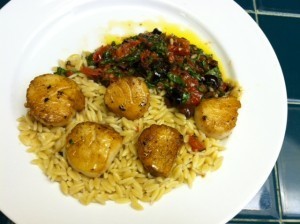
Skillet Scallops with Orzo and Tomato Vinaigrette
During Lent it is a challenge to prepare a variety of fish dishes that everyone in the family can agree upon. I love scallops, my husband… not so much. This particular recipe is one that I have wanted to prepare for a while. It is from the Bobby Flay cookbook Grill it! It is based on a classic scallop dish called Scallops Provençale.
I used my iron skillet for this recipe because it was rainy outside. As a result, I did not get the nice char lines on the scallops.
Ingredients:
6 plum or ripe tomatoes, I used about 12 sliced grape tomatoes 1/3 tablespoons extra-virgin olive Kosher salt Freshly ground black pepper 2 cloves garlic, finely chopped 1/4 Niçoice or Kalamata olives 1 tablespoon finely chopped fresh thyme leaves 4 tablespoons coarsely chopped fresh basil leaves 1 pound sea scallops, muscle removed
Method:
Heat your skillet to high. Toss tomatoes with 2 tablespoons of olive oil and season with salt and pepper. Place skin down in hot skillet and allow to become charred, about ten minutes. Remove the tomatoes from the pan and put to the side in a small bowl.
Immediately add the rest of the above ingredients, reserving 1/4 of the oil for the scallops and 1 tablespoon of the basil for garnish. Let this mixture rest at room temperature for at least half an hour. Do not refrigerate.
Mop out the cooled skillet with a paper towel, heat to high, brush the scallops with the remaining olive oil and season with salt and pepper. Cook scallops for 3-4 minutes, until golden, and then flip and cook on the other side for an additional 2-3 minutes. Place a scoop of the tomato vinaigrette in the center of the plate, arrange the scallops, drizzle the scallops with some of the liquid from the vinaigrette, and sprinkle the remaining basil across the scallops. I prepared orzo and placed the scallops on them with the vinaigrette to the side. The next time I will put the tomatoe vinaigrette in the center and arrange the orzo and the scallops around them. This way the olive oil will be absorbed by the orzo and won’t be wasted. Enjoy!
April 2, 2014
Smoky Fish Chowder
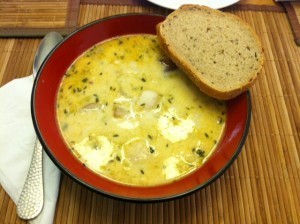
"Chowdah, Bobby, Chowdah."
I love soup. I had made lobster stock from the shells of our Valentine’s dinner and was searching for a recipe I could embellish with the velvety taste of this crustacean. When I saw this recipe in the Tampa Bay Times I knew I could add my own touches and create something memorable. The only caveat I have to the article is that if you are Roman Catholic and observe meatless Fridays you will need to omit the bacon. The article referred to this as appropriate for Lent and for my observance it is not. It is a delicious soup and the basic recipe could be enhanced by adding some small shrimp along with the white fish.
Ingredients:
4 slices bacon, diced 3-4 tablespoons butter 2 medium leeks, white and green parts, thinly sliced
3/4 teaspoon kosher salt 1/4 teaspoon plus hot smoked paprika 1/4 cup dry white vermouth or white wine
2 1/2 cups lobster stock 1 cup water 1/2 red or fingerling potatoes, sliced thinly into 1/4 inch rounds
4 thyme sprigs 2 cups whole milk, or 1 1/2 2% and 1/2 cup half-and-half 10 ounces flaky white fish, such
as flounder or cod, cut into 2-inch chunks
Method:
Brown bacon until crisp, about 7 minutes, in a heavy pot over medium-high heat. Use a slotted spoon to transfer bacon to a paper-towel-lined plate to drain.
Spoon off all but 2 tablespoons of bacon fat from the pot. Add butter and let melt. Add leeks and a pinch of salt; cook, stirring frequently, until leeks are soft, about 7 minutes. Stir in paprika; cook 1 minute. Pour in vermouth and simmer until almost completely evaporated, about 3 minutes. Stir in fish or lobster or shrimp stock, 1 cup water, potatoes, thyme and remaining salt. Simmer until potatoes are tender, about 25-30 minutes.
Add milk, half-and-half and cooked bacon to pot; bring to a simmer. Add fish and cook until just opaque, 2 to 4 minutes. Use a fork to flake fish into large pieces. Taste and adjust seasoning if necessary. Remove thyme stems. Serve immediately. We reheated the leftovers the next day and they were delicious.
Makes 3 to 4 servings.
Source: New York Times
March 26, 2014
Authors Eat…
 This month Authors Eat… features Tasmanian writer T.D. McKinnon, a colleague and contributing author at Indies Unlimited. T.D. is the definition of a survivor who has achieved impressive success in many areas of his life. He is an intriguing guy who I fondly refer to as The Asset. He is actively involved with causes near and dear to his heart, and many victims of child abuse have benefitted from reading the memoir of his childhood. I have found him to be kind, witty, and always a class act. Enjoy this glimpse into why he loves to cook, and check out his books on the links provided.
This month Authors Eat… features Tasmanian writer T.D. McKinnon, a colleague and contributing author at Indies Unlimited. T.D. is the definition of a survivor who has achieved impressive success in many areas of his life. He is an intriguing guy who I fondly refer to as The Asset. He is actively involved with causes near and dear to his heart, and many victims of child abuse have benefitted from reading the memoir of his childhood. I have found him to be kind, witty, and always a class act. Enjoy this glimpse into why he loves to cook, and check out his books on the links provided.
From the author…
I’ve always enjoyed and had an affinity with cooking. I do most of the cooking at home, but that’s probably because I’m the first to get hungry.
When I was ten my mother returned to the workforce and my seven year old sister and I inherited the job of preparing the evening meals; among other things. At thirteen and in my second year of high school we had to take metalwork shop, which I hated. From the very first lesson I always ended the period with a massive migraine from all the banging of hammers, screeching drills, files and hacksaws that scraped my nerves bare, not to mention the various smelting and welding fumes that permeated everything. After suffering this regular torture for two years I petitioned our headmaster to be allowed to swap my metalwork periods for the cooking classes.
At that time, no schoolboys were taking cooking in the UK. Luckily, our headmaster considered himself a bit of a ground breaker; something I’d been counting on. After the summer break of 1963, I was one of eight boys at the Keresley Newlands High School to pilot the new domestic science programme for boys; effectively, we were the first boys in the United Kingdom to take domestic science as a subject.
I did very well at cooking, as did most of the boys. Approaching Christmas time every year, the fourth year cooking students made Christmas cakes, which were displayed before the entire school and then judged in a competition. When it was our turn, I took third place, with two other boys placing in the first ten. I thought seriously about becoming a chef, in fact I was enrolled to attend the prestigious Henley Catering College. I joined the army instead, not the catering corps: the British Parachute Regiment (The Red Devils). You will find details of all the aforementioned, and much more, in my childhood memoir: ‘Surviving the Battleground of Childhood’.
My food tastes have changed dramatically over the years; as a young man I did the usual red meat thing, the spicy and hot thing (Indian curries, Mexican food et cetera) and later I was heavily into Thai, Chinese and then Japanese food. However, my food tastes changed most dramatically when (as a bodyguard) I was looking after a lady, the president of an animal rights group, who had a death threat hanging over her head. To cut a long story short, I became a vegan (consuming no animal products of any description) for about eight years. I haven’t been a vegan for some fourteen years now but my eating habits were changed for all time; suffice to say the only meat I eat is fish. So, without further ado, here is one of my favourite recipes:
‘Lemon & Garlic, Tasmanian Salmon’
Ingredients:
Brown rice
Tasmanian Salmon
Lemon
Garlic
Black pepper
Broccoli
Baby carrots
Preparation:
One handful of brown rice per person, bring to boil and simmer for twenty-five minutes. One portion of salmon per person (for obvious reasons I use Tasmanian salmon, but feel free to utilise your most local fresh salmon). Roll the salmon portion(s) in freshly squeezed lemon juice. Crush one clove of fresh garlic (the fresher the better) onto each salmon portion. Grind a liberal amount of black pepper (or to taste) onto each salmon portion. Squeeze a liberal amount of fresh lemon juice into a non-stick pan, apply the salmon to the pan, cover with lid and poach slowly on a low heat (12-14 minutes depending on the thickness of the portions). Steam the vegetables until they are cooked but still crisp (8-10 minutes). Serve the salmon on a bed of brown rice, pouring the pan juices over the salmon (Optional: garnish with a twist of fresh lemon), and add the steamed vegetables to your plate. Sit down and enjoy with a glass of your favourite Sauvignon Blanc.
http://www.amazon.com/T.D.-McKinnon/e/B0079QHFEW
http://www.amazon.co.uk/s/ref=nb_sb_noss?url=search-alias%3Ddigital-text&field-keywords=T.D.McKinnon
http://www.smashwords.com/profile/view/TDMcKinnon
The Culture and Cuisine Club
- L.A. Lewandowski's profile
- 102 followers



